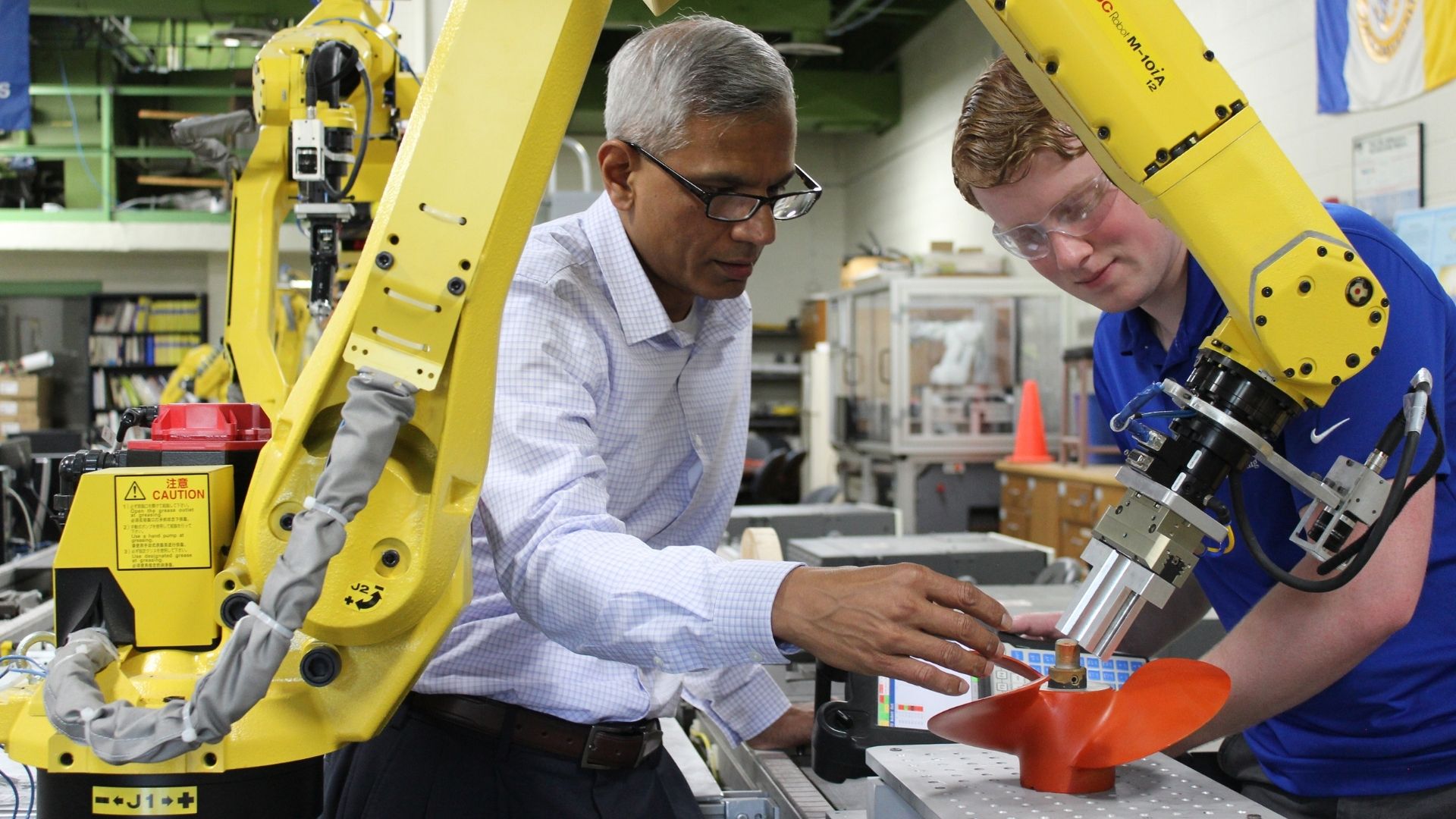Want to create the high-tech machines of the future? A degree in robotics engineering might be a good fit for you.
July 2019

Lake Superior State University Robotics Director Jim Devaprasad (left) with a senior level mechanical engineering student, in the robotics lab. Photograph courtesy Lake Superior State University
It’s easy to think of robots as fantastical science fiction inventions; automatons that live only in books, movies and the imagination. But the reality is quite different.
From farms to factories, medical facilities to mining operations, robots, large and small, are increasingly playing an important role in lives and industries around the world. Regardless of whether these highly-complex machines are harvesting crops, assembling products or helping patients recover from surgery, they would be nothing without the experts who design them.
Robotics engineering—the art, craft and science of creating and applying robots—is a young but rapidly growing area of study in the United States. An increasing number of American institutions, including Widener University in Pennsylvania and Lake Superior State University (LSSU) in Michigan, are offering dedicated majors in the field. And, for the right student, earning a graduate or undergraduate degree in robotics engineering can be a remarkable experience.
Nick Lubeck is a freshman studying robotics engineering at Widener University. He describes the discipline as an alchemy of electrical and mechanical engineering, with a focus toward computer science. “Robotics engineering can be applied to any industry that exists,” he says, “so a wide range of knowledge must be given as a basis. Then, it splits into more specific fields and applications.”
When it comes to classwork, robotics engineering students like Lubeck engage in a wide range of fascinating challenges. Deep studies into computer programming and electrical, mechanical and manufacturing engineering are key, says LSSU Robotics Director Jim Devaprasad. Xiaomu Song, associate professor at Widener University’s department of robotics engineering, emphasizes the importance of studying physics, mathematics, circuitry, microprocessors, kinematics, machine design, artificial intelligence and mechatronics as well.
Broader skills like communication, creativity and strategic thinking can also be key to success in robotics. “Being inventive in solving problems and having the ability to communicate these solutions are vital to any engineering discipline,” says Lubeck.
Widener University and LSSU make it easy for international students to find out more about their robotics programs and apply to join the fun. Students from India should expect to provide a variety of documents, including proof of proficiency in English and standardized test results demonstrating the skills and experience needed to thrive as a robotics engineer.
Both institutions also offer an array of scholarships and financial aid options. LSSU, for instance, offers a dedicated robotics scholarship to incoming freshmen. And through the university’s One Rate Tuition program, students from around the world pay the same lower rate of tuition as those from Michigan.
Widener University offers opportunities like the #YouAreWelcomeHere scholarship, which covers a minimum of 50 percent of tuition costs for selected international students. Other scholarship opportunities include the chance for incoming engineering students to receive free laptops.
For those who receive an undergraduate or a graduate degree in robotics engineering, Devaprasad describes outstanding career opportunities, flexibility and earning potential. There are “tons of job opportunities all over the world,” he says, “with a variety of industries and businesses already in robotics or looking to get into robotics.” Furthermore, the work is great fun, he says, emphasizing that it’s hard to get bored with such vast opportunities in so many different fields.
What sort of student should pursue a degree in robotics engineering and help meet the global demand for new experts in this discipline? “Anyone who is interested in technology and its applications in industry and day-to-day life,” says Devaprasad, as well as those who have “a desire to help solve problems and make human life better.”
The world of robotics does, however, present its own unique challenges. When entering the workforce, Devaprasad warns, newly-minted robotics engineers should be ready to face perceptions like robots replace people and that the growth of robot usage will lead to massive unemployment. “Actually, so far, studies have shown that in industry, robots do not replace people, but do displace people, with a greater need for people with skills, education and training,” he says. “Often, for every robot used in the field, there are two new jobs that become available.”
For Lubeck, “The biggest challenge that robotics engineers face is failure. You can say that for any major, but robotics engineering sets the bar for failure as a challenge. Improvement and development is the basis of robotics. And when that fails, it does not feel good.”
No matter how bad it may feel, though, Lubeck advises persevering when engineering projects don’t go as hoped for, working hard and never backing down from a problem. “Seeing something work is one of the greatest feelings that you can have,” he says. “With robotics projects, there’s really no limit or end to what you can do.”
Michael Gallant is the founder and chief executive officer of Gallant Music. He lives in New York City.
COMMENTS